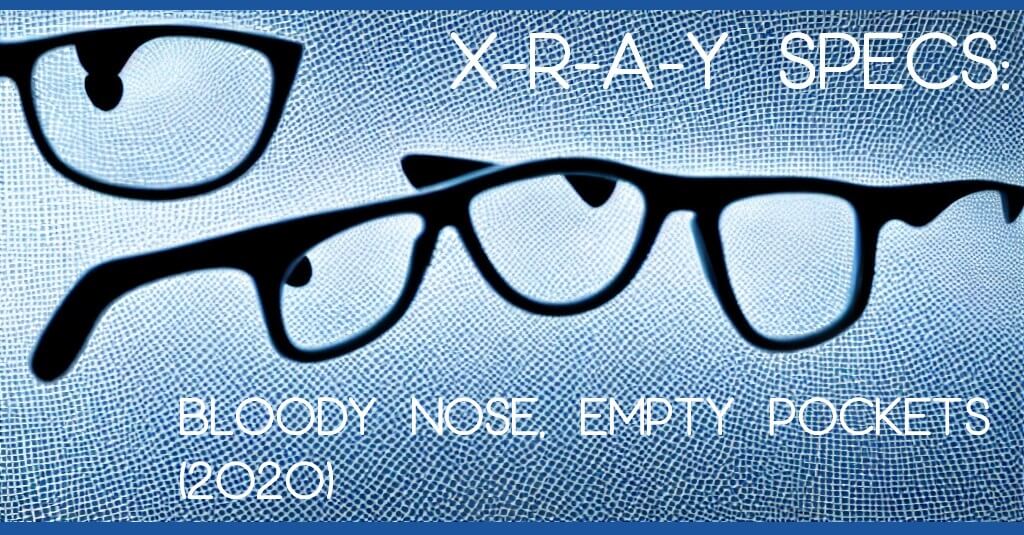Welcome to X-R-A-Y Specs, a film roundtable in which four of our radiological technicians converse about movies. This month’s selection is Bloody Nose, Empty Pockets, a 2020 documentary filmed in 2016 and directed by Bill Ross IV and Turner Ross.
Its status as a documentary is somewhat up for debate, but its reception was not; critics fucking loved this movie, and some of us did too. Our conversation follows.
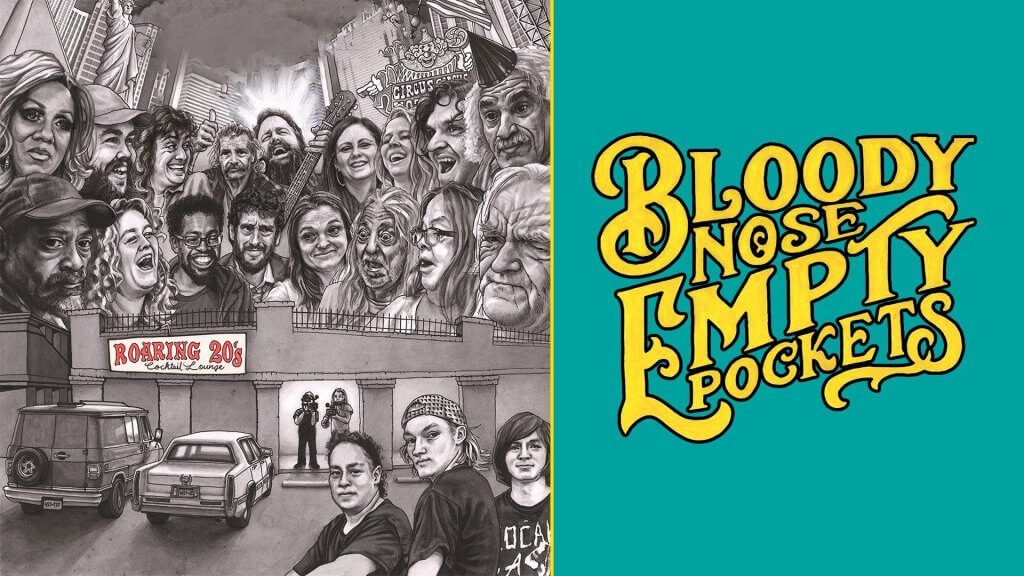
Katharine Coldiron: Well thanks for that hour and thirty-eight minutes of heartache.
Rebecca Gransden: Bittersweet. Did you guys know anything about the stylistic choice before seeing it? I went into this near completely blind, bar a brief summary and noticing it logged under the documentary category. And it does play with categorisation. At first it came across as guided improvisation but as it progressed I found it akin to the type of constructed reality more associated with TV, if these distinctions mean anything anymore. Very often, for me, this style overreaches with authenticity and pushes through to the other side, accentuating the artifice, which has an interesting effect, and is successful in this case. I find myself constantly aware of an imagined filmmaker presence offscreen, saying “Just be natural. Do what you do.” Not a positive or negative overall to me; as with any choice of this kind, it does depend upon the context and execution, the suitability.
I was also wondering if this choice, the blurring of lines between documentary and scripted reality, parallels the experience of the majority of the characters and their relationship to the bar. For most of them the proxy family they find at the bar seems to be constructed out of habit, convenience, shared reliance on drink and a search for connection of some kind. In so doing they construct a reality centered on the bar and its clientele, one based on flimsy foundations, as illustrated by elected main character Michael’s parting shot as he leaves the place for the final time, stating that they don’t really know him at all. I’m working my way backwards from the end here, but I feel that’s appropriate.
Jillian Luft: As this was my selection, I sincerely apologize, Katharine. I’m a sucker for glimmers of hope in hopelessness. And this film nails it.
I will confess I had no idea about the stylistic choice on my first watch. I was (naively? stupidly?) under the impression for at least a half hour that these were real bar patrons at a real Vegas dive. Out of curiosity, I reached for my phone and looked up the bar because I wanted to visit it (hah). Temporary disenchantment set in, but then I was able to thoroughly enjoy the movie on its new terms.
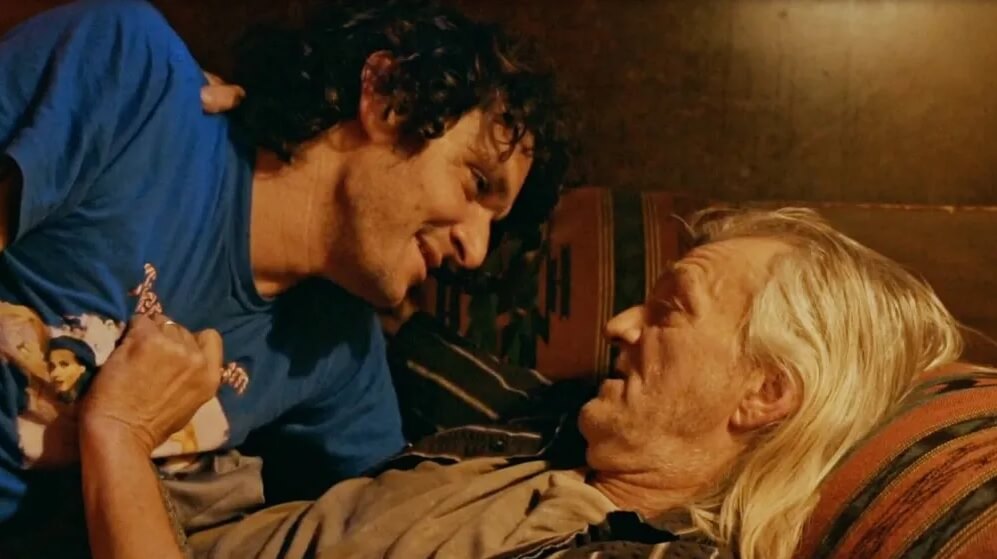 Of course, I spent hours post-watch, looking up each “actor” in the film, desperate to learn how much their real personality/life overlapped with what was portrayed on-screen. I gasped when I discovered Pete (the tatted-up lush that Michael warns it’s not too late for him to get his life together) died in 2020 of a drug overdose in Florida. Art/reality forever blurring in devastating ways.
Of course, I spent hours post-watch, looking up each “actor” in the film, desperate to learn how much their real personality/life overlapped with what was portrayed on-screen. I gasped when I discovered Pete (the tatted-up lush that Michael warns it’s not too late for him to get his life together) died in 2020 of a drug overdose in Florida. Art/reality forever blurring in devastating ways.
KC: I watched probably an hour and fifteen minutes before I looked up the film. I’m troubled by the background story of it, and I admit my first thought was “this is Lifespan of a Fact all over again.” I studied that book, wrote an essay partially about it, was horrified by undergrads’ reaction to it (they didn’t care!!!), still recommend it and think about it and use it to galvanize my creative process.
But in fact this is not that, because the filmmakers don’t care about the truth part of it the way Jim Fingal does. They made this false world, in imitation of a true one, kind of…in good faith? Apparently they were trying to recreate something real they’d experienced, to sculpt it into an audience-ready feature-length film, and to call it a documentary. I’m somehow more okay with that than with Lifespan, because of what I learned from Errol Morris 20 years ago about the lens of the documentarian. More okay, not totally okay.
Anyhow, the content of the film is a little more important to most audience members than to me—I don’t know if that’s so for you all—and to that I have plenty to say, too. I think this shows, in a roundabout way, a more useful and heartrending way, that everyone matters to someone. It’s a far more graceful method than, I don’t know, interviewing the family members of convicted killers, or something. Most of these people have been discarded in one way or another, but they have spontaneous moments of beauty and love, between each other and directed outward. Michael especially, I mean there’s a reason we follow him from dawn to dawn, that’s obviously part of the sculpt, but all of them. It’s a lovely piece of work.
The Vanity Fair article I shared with you really expresses most of what I feel and think about this movie. Lawson calls this “a staggering piece of filmmaking” regardless of the trick of it, and I utterly agree with that assessment.
JL: Wholeheartedly agree that this is a “staggering piece of filmmaking” and a staggering reflection of my soul. No hyperbole intended.
While I am by no means a dive bar regular, to the extent of these characters, I feel most at home in a dirty joint with a jukebox and cheap booze. Perhaps it’s my Florida upbringing or maybe it’s my affinity for lost souls and their invaluable wisdom that seeps through like alcohol seeps through their pores. Or I might be more like them than I care to admit.
I think the story this film tells is one of ephemeral connection found in unlikely places with unlikely people. It’s a story that can happen in any cruddy bar across America and does on a nightly basis. It is a wild, hilarious and heartbreaking saga comprised of the stories of its regulars, their oft-repeated tales of past fortunes and glories, their rarely confessed stories of haunting shame and quiet suffering, their elaborate, personal narratives about redemptive futures that will never 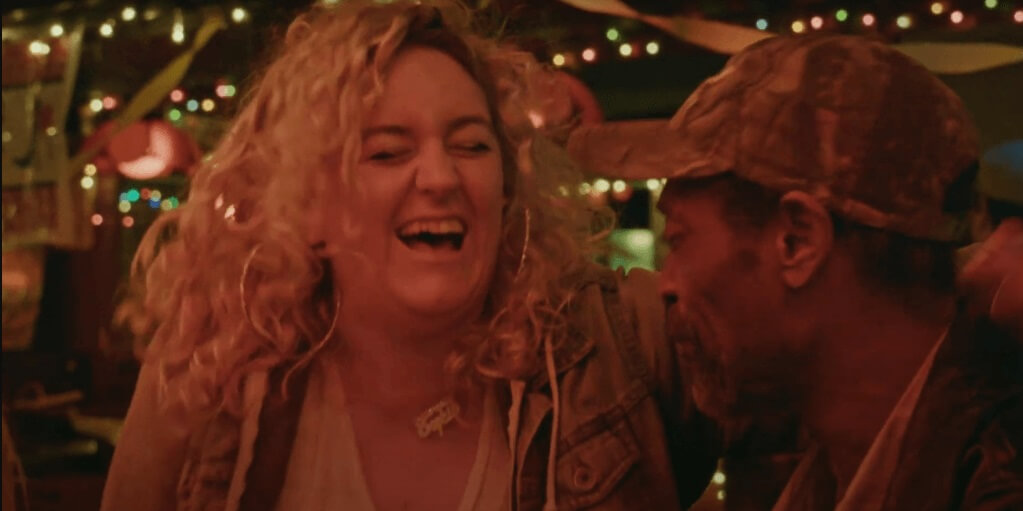 come to pass. And it’s so goddamn beautiful. These are the stories I’m drawn to again and again. The ones with highly unreliable narrators. Somewhere, obscured beneath the smoke of their own bullshit hubris and self-serving embellishments, is a piercing clarity on the human condition. Much like this movie, through their lies, we discover as more poignant truth. When you are audience for one of these unreliable narrators, especially a stranger, it can not only feel like a privilege but a turning point in your life.
come to pass. And it’s so goddamn beautiful. These are the stories I’m drawn to again and again. The ones with highly unreliable narrators. Somewhere, obscured beneath the smoke of their own bullshit hubris and self-serving embellishments, is a piercing clarity on the human condition. Much like this movie, through their lies, we discover as more poignant truth. When you are audience for one of these unreliable narrators, especially a stranger, it can not only feel like a privilege but a turning point in your life.
Tex Gresham: Sorry, I’ve been busy arm-wrestling a depressive episode—this movie both helped and didn’t. I knew about the manufactured idea surrounding this film only because I was in Vegas when it came out and I tried to look up where the bar had been and the history of it. At first I thought, judging by the interior, that it was filmed at Atomic Liquors—which is a well-known bar with a long list of famous patrons including Hunter S. Thompson, the Rat Pack, and Barbara Streisand. It’s a well-known and often-busy place, but it’s 100% a dive (and kind of a shitty one). I’d been there once and the patrons of 2019 felt very similar to those in Bloody Nose, Empty Pockets. But when I learned the “truth,” I didn’t really care that the bar never existed anywhere in the city. There’s an interesting implication by setting it in Vegas but having it happen in Louisiana—that this is life lived anywhere and everywhere. Put it in a different city, a different country, in a different language, and nothing would change. And it’s in that universality that the movie achieves something deeply gut-punching for me: every single life on this planet is worthy of a little bit of screen time and the empathy that comes with watching that life.
But until you discover—because it is up to the viewer to discover—the truth, it absolutely feels in line with the attitudes, outgoingness, and proudly “trashy” people of Las Vegas. And like Jillian, I have an Achilles heel for people who drink deeply from the River Styx and walk around drunk, completely vulnerable, but are somehow more willing to embrace the flaw of the thing we all have to do—live.
KC: Tex, you generous motherfucker.
JL: I’ve also been in the throes of depression, Tex, and I’m struggling with articulating what this movie accomplishes because I fear I won’t do it justice. I tried a bit to get at it so far, but what you’ve noted about “every single life on this planet is worthy of a little bit of screen time and the empathy that comes with watching that life,” man, that’s it. These “trashy” patrons bear witness to each others’ lives. They see one another at their absolute worst and they don’t just tolerate it, they accept it. They look out for one another. They are a motley crew but a real community. They couldn’t be a community without The Roaring 20s.
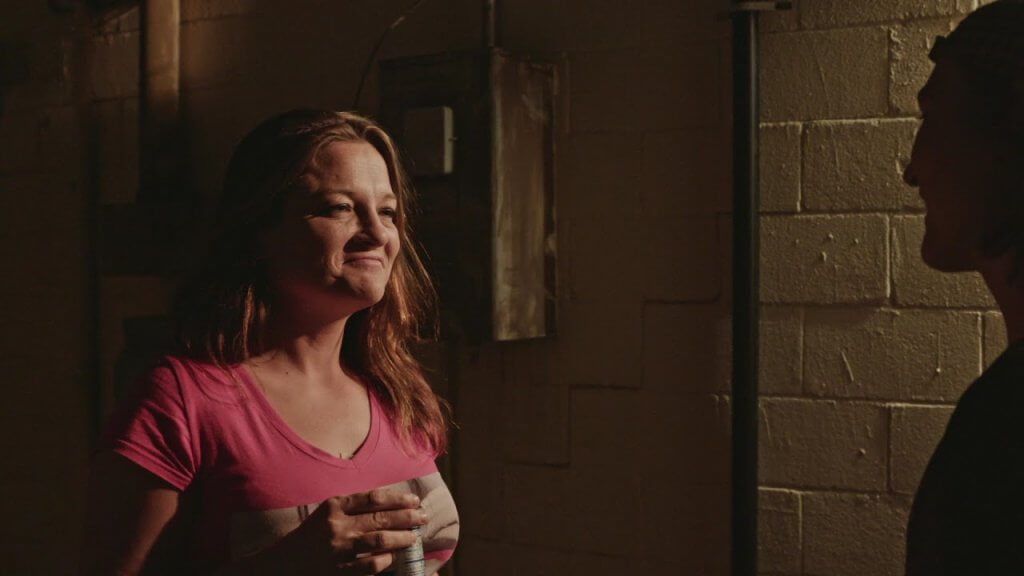 RG: The Vanity Fair article picks up on a point I found apparent when watching it—that the characters are all examples of a type: the older guy fixated on lost opportunities, the haunted veteran, the tough single mother, the young guy angry at the previous generation, the working girl with a good heart, I could go on. This is not heavy-handed at all, a real achievement for that, and testament to the wisdom of the filmmakers and their choices. The single mother stood out to me as particularly authentic, and the interactions between her and her very normally acting-out teenage son exemplify the universality everyone is detecting. These are people familiar but very often misrepresented on screen. The quietness of the veteran, sitting somewhat distanced from the general chatting, and his brief, at one point impatient, at another emotional, contributions carry much weight. I suspect the shot of him walking slowly away from the bar for the final time will be the image that lingers with me the longest.
RG: The Vanity Fair article picks up on a point I found apparent when watching it—that the characters are all examples of a type: the older guy fixated on lost opportunities, the haunted veteran, the tough single mother, the young guy angry at the previous generation, the working girl with a good heart, I could go on. This is not heavy-handed at all, a real achievement for that, and testament to the wisdom of the filmmakers and their choices. The single mother stood out to me as particularly authentic, and the interactions between her and her very normally acting-out teenage son exemplify the universality everyone is detecting. These are people familiar but very often misrepresented on screen. The quietness of the veteran, sitting somewhat distanced from the general chatting, and his brief, at one point impatient, at another emotional, contributions carry much weight. I suspect the shot of him walking slowly away from the bar for the final time will be the image that lingers with me the longest.
My preferred sections occur early on, and the film impressively captures the various moods of a bar day, from the ragged casually good-natured tone of the afternoon crowd, moving through to the mostly warm high sprits of evening, then onto the inebriated oversharing and tears and fists of late into early hours. Music is mostly nostalgic, classic jukebox. We’re back to universality, as the tracks are, for the main part, ubiquitous, commonly shared cultural reference points, but made personal by the associations we impose on them. Universality lives in the specifics. Many of the regulars are defined by the past, or a past that never happened, and possess a conflicted relationship to the bar. For some it is definitely a crutch, even if a warm one. It’s difficult not to focus on nostalgia, as the soundtrack oozes it, suggests times passing, compounded by the retro titles fronting the film, the shots of the city in saturated tangerines and pinks, all hazy and intoxicated, sure, but also suggestive of a collective history, one kept alive by the bar and its people. It’s a sanctuary of sorts, and some of the regulars will stagger off to another place just like it, but others won’t take its closure that easily.
Is it a commentary on a real shift in US society—towards homogenisation, economics forcing independents out of business—or do these places come and go, represent a space that by its nature is in a perpetual state of long goodbye, hence attracting people who identify with that? I see it was released at the turn into the 2020s, and parallels itself to the 1920s with the name of the bar being The Roaring 20s, which I assume is either dryly ironic or joyously playful, maybe both.
TG: I think it’s a cyclical thing. The early 1980s saw an economic crisis that closed many independent businesses, as well as the extreme corporatization of everything—especially the arts. Eagle Pennell’s Houston-shot Last Night at the Alamo is an earlier version of Bloody Nose. It’s the story of a dive bar on the last night before it’s shut down—except that it’s all very scripted and cheaply acted and doesn’t ring an emotional bell as well-pitched as the latter. But I feel like both movies are absolutely a commentary on the shifts in US society.
I feel like we’re constantly moving towards a state where we, the Individual, are no longer the individual, no longer relevant as a person, but rather only relevant as numbers or data. Even at the personal level, our relevancy between others only exists as these words you’re reading or likes on a post or replies to a tweet—especially in this age where all of our communication is done via screens and not face-to-face. And so places like The Roaring 20s are places where we celebrate the individual, where we give the individual a spotlight. And like with Last Night at the Alamo, Bloody Nose is about saying goodbye to these places where the individual can exist and be seen, and the goodbye is caused by the shift towards homogenization, by failing economics, and so on. All the shots where we see one of the patrons sitting alone reflects this movement towards societally-caused outsidering and loneliness.
Man, I’m real chipper with this one.
KC: I’ll bring you back by reminding you of your word “cyclical.” You and I both know how Hollywood repeatedly locks down and then loosens up again: Hays Code vs. pre-Code, MGM’s height in the 1950s vs. New Hollywood’s height in the 1970s, the dull-ass box-office content in the 80s vs. the Weinstein-driven indie influx in the 90s. In my own lifetime I’ve watched bookstores go from smallies to big-boxers, and now that Borders is gone and B&N has shrunk significantly, the smallies are back in again. I don’t know anything about the bar business, but surely it has the same cyclical patterns, from chains to sole-ownerships and back again. Dive bars may individually fall, but they’ll always rise again.
JL: Concur with Tex that dives are places where we champion the individual and give them their due. Yet, I think it’s also worth mentioning that to be a true dive bar, you must be steeped in a rich, albeit unsavory, collective history as expressed by those quick shots of photo collages from years past proudly hung on the walls of The Roaring 20s. The legacy of any bar is constructed through the patronage, and camaraderie, of its regulars.
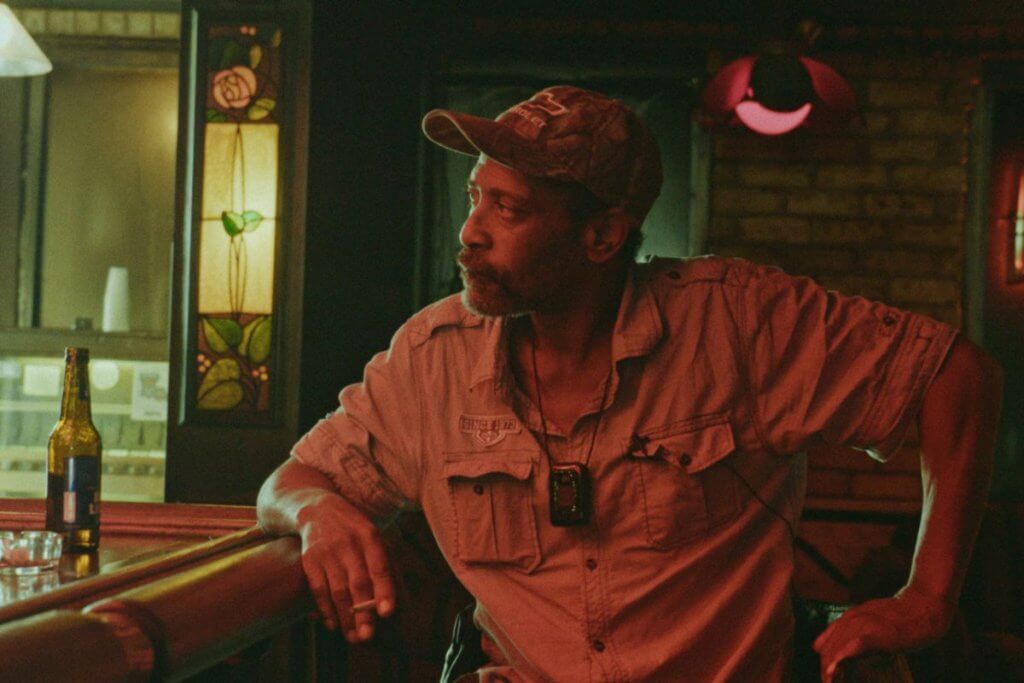 Similarly, the lone individual needs the group even if they don’t admit it, even if they sit in the corner most of the night like the vet character. Rebecca touched on that final scene of him walking out of the bar. It’s brutal, reaching an honesty in a close-up of his face that you wish you could turn away from but can’t. You know how his own country has turned away from him and so you watch his former refuge dissolve in the wet agony of his eyes.
Similarly, the lone individual needs the group even if they don’t admit it, even if they sit in the corner most of the night like the vet character. Rebecca touched on that final scene of him walking out of the bar. It’s brutal, reaching an honesty in a close-up of his face that you wish you could turn away from but can’t. You know how his own country has turned away from him and so you watch his former refuge dissolve in the wet agony of his eyes.
In that same tragic moment, I think back to his character, earlier on in the film, dancing alone to Michael Jackson’s “Thriller.” Something approximating unfettered joy in his movements while the bar crowd continues imbibing with raucous abandon, most of them missing out on this candid moment of self-celebration. Is this a moment of levity? Of nostalgia? Of heartbreak? Is it all of these, depending on who’s watching? Was it improvised or scripted? Are all of these questions futile? Is the only one that matters whether it feels true? Yes.
And I do want to address what Rebecca discussed about music. Music is definitely a character in this film, just as music is the honorary patron in any self-respecting dive bar. If you don’t have TouchTunes or some sort of jukebox contraption in your hole-in-the-wall, you should be run out of business. Sorry.
Music makes the moment. There’s a particular alchemy that can occur at any hour in a bar. And when it does, an indelible memory is created. What’s required is a moderately high buzz, good vibes and the perfect song. The perfect song is usually nostalgic. It transports you to an idealized version of your past while also ensuring you’ll remember this new experience of the song, imbued with fond recollections and an inebriated optimism for what tomorrow could bring based on the fleeting moments of ecstasy that have come before. The jukebox jams played in Bloody Nose are near genius in capturing this warped interplay of time and memory, endemic to the bar setting.
The song selections are almost too on-the-nose (Kool and the Gang’s “Celebration,” Roy Orbison’s “Crying,” The Spice Girls’ “Wannabe”) but it’s their generic nature that enhances the scenes’ verisimilitude. You believe these characters would choose these songs and you can even guess as to who requested what and why. (My money’s on the lovelorn hippie Lowell choosing Hall and Oates’ “She’s Gone.”)
Katharine’s absolutely right. Like Terminators or cockroaches, dive bars will always rise again. They’re one of the last bastions of organic and spontaneous social connection. As Tex mentioned, they’re the stubborn long-standing antidote to the toxic dehumanization we increasingly experience as our lives are lived out on social media. There will always be a demand for a place where locals can drink cheaply and abundantly irl. For better or worse (and I think it’s both), frequenting a dive bar is an American tradition.
Bloody Nose pays homage to this tradition and upholds it as a microcosm of American life through its artificial/unorthodox means of filmmaking and storytelling. On this repeat viewing, I’ve decided that it couldn’t have been as honest and as deeply human a portrait and tribute to this way of living if it’d been filmed, or told, any other way.
Bloody Nose, Empty Pockets is available to rent on various streaming platforms, or for free on Kanopy.

